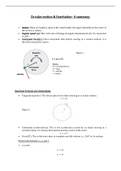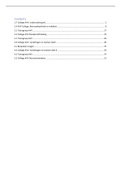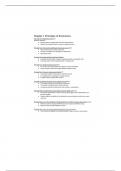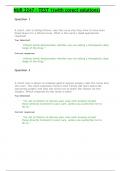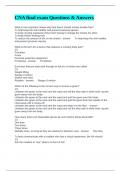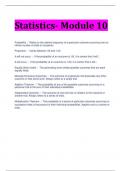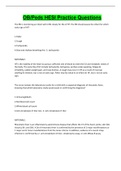CHAPTER 9: THE CAPITAL ASSET PRICING MODEL
CHAPTER 9: THE CAPITAL ASSET PRICING MODEL
PROBLEM SETS
1. E (rP ) = rf + β P [ E (rM ) − rf ]
.12
.18 = .06 + β P [.14 − .06] → β P = = 1.5
.08
2. If the security’s correlation coefficient with the market portfolio doubles (with all
other variables such as variances unchanged), then beta, and therefore the risk
premium, will also double. The current risk premium is: 14% – 6% = 8%
The new risk premium would be 16%, and the new discount rate for the security
would be: 16% + 6% = 22%
If the stock pays a constant perpetual dividend, then we know from the original data
that the dividend (D) must satisfy the equation for the present value of a perpetuity:
Price = Dividend/Discount rate
50 = D/0.14 D = 50 0.14 = $7.00
At the new discount rate of 22%, the stock would be worth: $7/0.22 = $31.82
The increase in stock risk has lowered its value by 36.36%.
3. a. False. β = 0 implies E(r) = rf , not zero.
b. False. Investors require a risk premium only for bearing systematic
(undiversifiable or market) risk. Total volatility, as measured by the standard
deviation, includes diversifiable risk.
c. False. Your portfolio should be invested 75% in the market portfolio and 25%
in T-bills. Then: β P = (0.75 1) + (0.25 0) = 0.75
4. The expected return is the return predicted by the CAPM for a given level of
systematic risk.
E (ri ) = rf + βi [ E (rM ) − rf ]
E (r$1 Discount ) = .04 + 1.5 (.10 − .04) = .13, or 13%
E (rEverything $5 ) = .04 + 1.0 (.10 − .04) = .10, or 10%
9-1
Copyright © 2021 McGraw-Hill Education. All rights reserved. No reproduction or distribution without the prior written consent of
McGraw-Hill Education.
, CHAPTER 9: THE CAPITAL ASSET PRICING MODEL
5. According to the CAPM, $1 Discount Stores requires a return of 13% based on its
systematic risk level of β = 1.5. However, the forecasted return is only 12%.
Therefore, the security is currently overvalued.
Everything $5 requires a return of 10% based on its systematic risk level of β = 1.0.
However, the forecasted return is 11%. Therefore, the security is currently
undervalued.
6. Correct answer is choice a. The expected return of a stock with a β = 1.0 must, on
average, be the same as the expected return of the market which also has a β = 1.0.
7. Correct answer is choice a. Beta is a measure of systematic risk. Since only
systematic risk is rewarded, it is safe to conclude that the expected return will be
higher for Kaskin’s stock than for Quinn’s stock.
8. The appropriate discount rate for the project is:
rf + β × [E(rM ) – rf ] = .08 + [1.8 (.16 – .08)] = .224, or 22.4%
Using this discount rate:
10
$15
NPV = −$40 + t
= −$40 + [$15 Annuity factor (22.4%, 10 years)] = $18.09
t =1 1.224
The internal rate of return (IRR) for the project is 35.73%. Recall from your
introductory finance class that NPV is positive if IRR > discount rate (or,
equivalently, hurdle rate). The highest value that beta can take before the hurdle
rate exceeds the IRR is determined by:
.3573 = .08 + β × (.16 – .08) β = .2773/.08 = 3.47
9. a. Call the aggressive stock A and the defensive stock D. Beta is the sensitivity
of the stock’s return to the market return, i.e., the change in the stock return
per unit change in the market return. Therefore, we compute each stock’s beta
by calculating the difference in its return across the two scenarios divided by
the difference in the market return:
−.02 − .38 .06 − .12
βA = = 2.00 βD = = 0.30
.05 − .25 .05 − .25
9-2
Copyright © 2021 McGraw-Hill Education. All rights reserved. No reproduction or distribution without the prior written consent of
McGraw-Hill Education.
CHAPTER 9: THE CAPITAL ASSET PRICING MODEL
PROBLEM SETS
1. E (rP ) = rf + β P [ E (rM ) − rf ]
.12
.18 = .06 + β P [.14 − .06] → β P = = 1.5
.08
2. If the security’s correlation coefficient with the market portfolio doubles (with all
other variables such as variances unchanged), then beta, and therefore the risk
premium, will also double. The current risk premium is: 14% – 6% = 8%
The new risk premium would be 16%, and the new discount rate for the security
would be: 16% + 6% = 22%
If the stock pays a constant perpetual dividend, then we know from the original data
that the dividend (D) must satisfy the equation for the present value of a perpetuity:
Price = Dividend/Discount rate
50 = D/0.14 D = 50 0.14 = $7.00
At the new discount rate of 22%, the stock would be worth: $7/0.22 = $31.82
The increase in stock risk has lowered its value by 36.36%.
3. a. False. β = 0 implies E(r) = rf , not zero.
b. False. Investors require a risk premium only for bearing systematic
(undiversifiable or market) risk. Total volatility, as measured by the standard
deviation, includes diversifiable risk.
c. False. Your portfolio should be invested 75% in the market portfolio and 25%
in T-bills. Then: β P = (0.75 1) + (0.25 0) = 0.75
4. The expected return is the return predicted by the CAPM for a given level of
systematic risk.
E (ri ) = rf + βi [ E (rM ) − rf ]
E (r$1 Discount ) = .04 + 1.5 (.10 − .04) = .13, or 13%
E (rEverything $5 ) = .04 + 1.0 (.10 − .04) = .10, or 10%
9-1
Copyright © 2021 McGraw-Hill Education. All rights reserved. No reproduction or distribution without the prior written consent of
McGraw-Hill Education.
, CHAPTER 9: THE CAPITAL ASSET PRICING MODEL
5. According to the CAPM, $1 Discount Stores requires a return of 13% based on its
systematic risk level of β = 1.5. However, the forecasted return is only 12%.
Therefore, the security is currently overvalued.
Everything $5 requires a return of 10% based on its systematic risk level of β = 1.0.
However, the forecasted return is 11%. Therefore, the security is currently
undervalued.
6. Correct answer is choice a. The expected return of a stock with a β = 1.0 must, on
average, be the same as the expected return of the market which also has a β = 1.0.
7. Correct answer is choice a. Beta is a measure of systematic risk. Since only
systematic risk is rewarded, it is safe to conclude that the expected return will be
higher for Kaskin’s stock than for Quinn’s stock.
8. The appropriate discount rate for the project is:
rf + β × [E(rM ) – rf ] = .08 + [1.8 (.16 – .08)] = .224, or 22.4%
Using this discount rate:
10
$15
NPV = −$40 + t
= −$40 + [$15 Annuity factor (22.4%, 10 years)] = $18.09
t =1 1.224
The internal rate of return (IRR) for the project is 35.73%. Recall from your
introductory finance class that NPV is positive if IRR > discount rate (or,
equivalently, hurdle rate). The highest value that beta can take before the hurdle
rate exceeds the IRR is determined by:
.3573 = .08 + β × (.16 – .08) β = .2773/.08 = 3.47
9. a. Call the aggressive stock A and the defensive stock D. Beta is the sensitivity
of the stock’s return to the market return, i.e., the change in the stock return
per unit change in the market return. Therefore, we compute each stock’s beta
by calculating the difference in its return across the two scenarios divided by
the difference in the market return:
−.02 − .38 .06 − .12
βA = = 2.00 βD = = 0.30
.05 − .25 .05 − .25
9-2
Copyright © 2021 McGraw-Hill Education. All rights reserved. No reproduction or distribution without the prior written consent of
McGraw-Hill Education.


